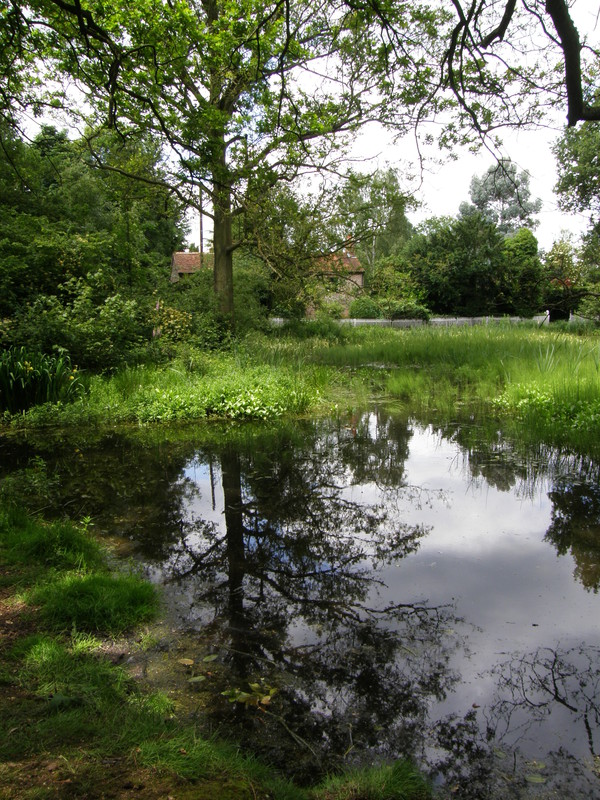
Today I didn't walk alone, sharing the short hop from Moor Park to Chorleywood with my mate Neal, who lives in Beaconsfield and therefore constitutes the closest thing to a local that I can muster. Sadly he wasn't able to enjoy the wall-to-wall blue skies I've been walking under for the last few days – the theme for today was only sunny intervals – but at least the rain that's approaching from the west held off, and when you're travelling light and don't have umpteen layers in your backpack, keeping dry is a pretty major objective.
This is an enjoyable and hardly stressful part of my tubewalk; indeed, if you ignore the Waterloo & City line and the three small segments left of the Circle line after walking the Metropolitan, District and Hammersmith & City portions, this is the shortest tubewalk I'm doing, at just six miles. What a good choice for sharing, then; alone, I doubt I'd have stopped for a leisurely mid-morning coffee in Rickmansworth or an enjoyable pint of IPA in the Black Horse on Chorleywood Common, and looking back on this quiet little leg, it's arguable that those were the highlights. I'm already looking forward to my next shared tubewalk, despite being a lone walker by trade.
Moor Park to Rickmansworth
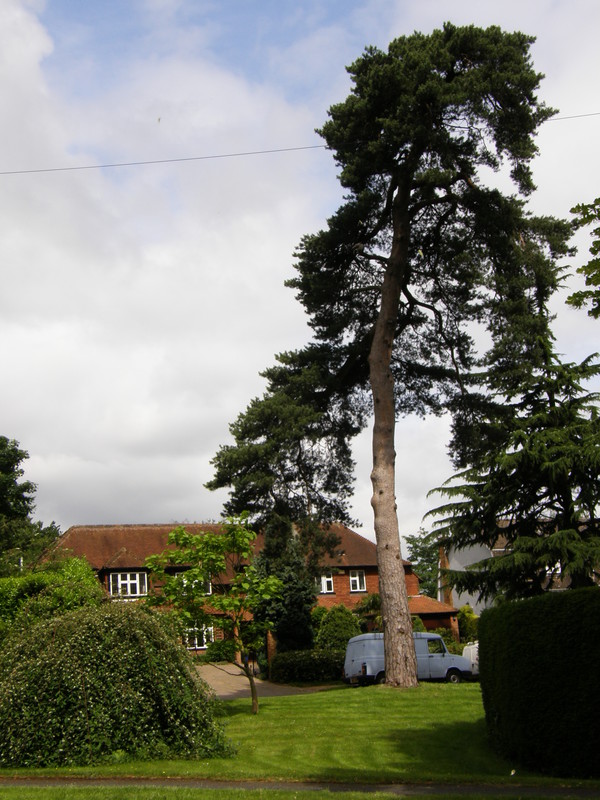
I was thankful early on for Neal's company, as without him I'm not sure I'd have had the nerve to tackle the walk's first hurdle. Leaving Moor Park station, we wandered past the friendly estate agents, along the small road that doubles as Moor Park's shopping precinct, and past the large houses that line Main Avenue, and I told Neal about the last time I'd been walking in this area, on my tubewalk from Wembley Park to North Harrow. One of the things that stuck in my mind was the western end of Sandy Lodge Road, where there was a manned booth at the entrance to a private estate, and there was absolutely no question of non-residents being able to poke their noses in and have a good look around... and then, just as Neal was describing his own experience of driving through a private estate in the area, a sign appeared round the corner saying that the road I'd planned to walk down was private and closed to through traffic.
'Bugger,' I said. 'What do you reckon?'
'Well,' said Neal. 'We're not traffic, are we?'
'Good point,' I said, and persuaded by this irrefutable logic, we headed west into the heart of Moor Park Golf Course, winding through a dense forest with glimpses through to long fairways and distant tees through gaps in the trees.
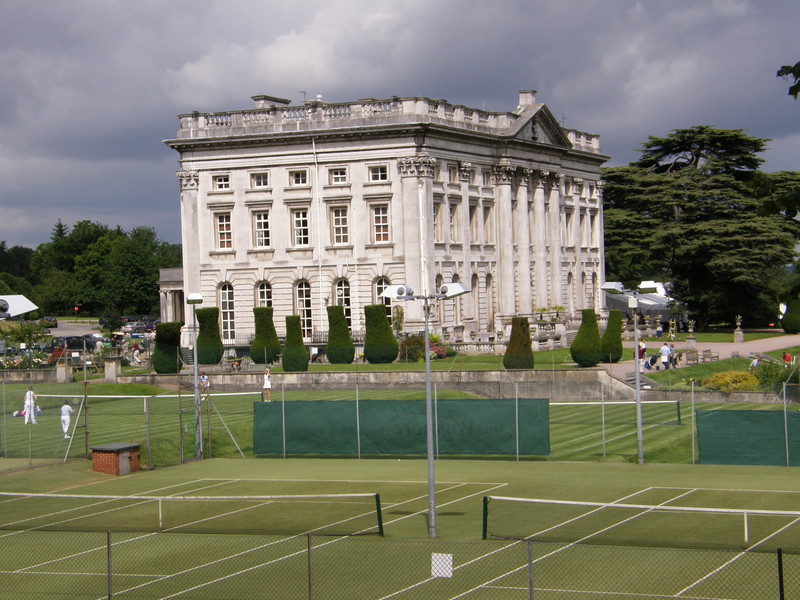
And then, pow! We came round a corner into a clearing, and standing there like a huge Lego experiment was this massive Palladian mansion, three storeys high and surrounded by tennis courts, marquees and, more worryingly, lots of expensively clad people pushing golf carts around. It felt like stumbling on a Bond villain's headquarters, out in the middle of the Hertfordshire countryside, and I was suddenly gripped by visions of us waltzing into the middle of this exclusive golfing cartel, being surrounded by henchmen and thrown in the dungeons for at least 42 days.
'Pah!' said Neal, a veteran of many an upmarket golf course. 'Wear a collared T-shirt, and you can go anywhere,' he continued, pointing to his attire, and he was right; if I squinted correctly, Neal almost looked like he was dressed for golf. 'You can be my caddy,' he said, and strolled off into the middle of the throng, clearly in his element, while I tried to sneak the odd photograph without trying too much to look like a long-haired trespasser.
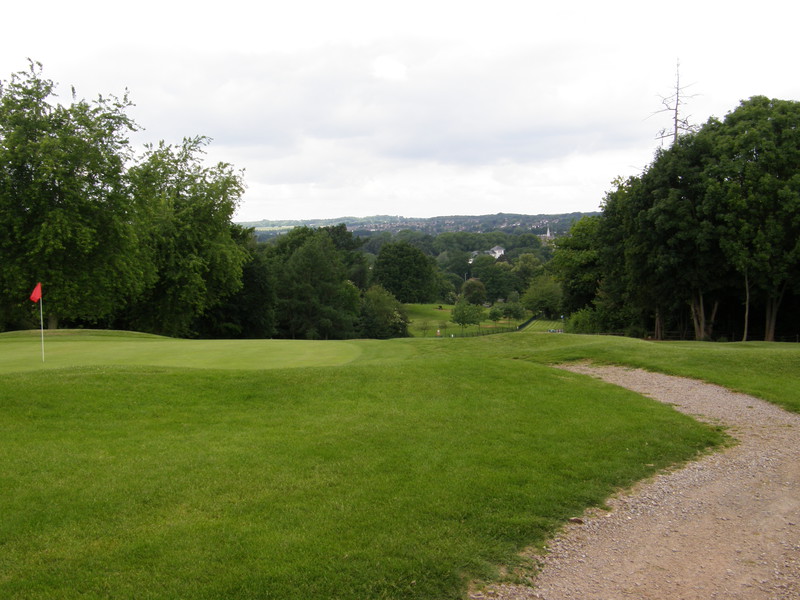
And then a man walked up to us, pulling a trolley behind him, and I thought the game was up. 'Excuse me,' he said in a Brummy accent, and my blood ran cold. 'Um, do you know the course at all?'
'No, sorry,' said Neal, 'I don't,' and off the man went, searching for his tee. It seemed that all the people milling around were strangers to the club, and according to a sign at the clubhouse (which the mansion turned out to be), Moor Park was hosting a charity tournament. Our cover was assured, and I even dared to fish out my Ordnance Survey map to work out exactly where the nearby public right of way was, so we could join it before being rumbled. And all the time, people flooded in and out of the clubhouse, or Moor Park Mansion as it's more properly known. There can't be many golf clubs with a palatial clubhouse dating from 1679, let alone many whose grounds were landscaped by Capability Brown, and I felt rather privileged to be there... especially as I wasn't supposed to be.
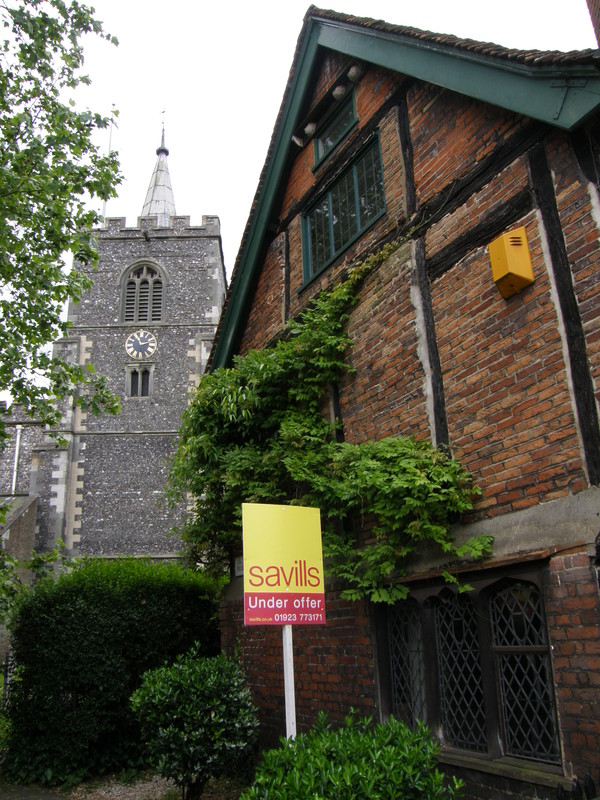
The right of way – which crosses the golf course from southeast to northwest – is the only legal way to walk across the golf course, and we joined it as it crossed the driveway, taking it via fairways and tees where groups of golfers waited to tee off in a shotgun start (which, Neal explained, is where groups of golfers assemble at each tee, and then tee off simultaneously, thus preventing each team having to wait endlessly at the first tee for all the other teams to tee off). After the mix of rain and sun that we've been having, Moor Park is a luscious place, with deep green rough and pristine putting surfaces, and as nobody was actually playing as we walked, it was relaxing in a way that walking across golf courses rarely is.
From the golf course, Rickmansworth is a short stroll along the A404, on the other side of the junction of the Grand Union Canal and the River Colne. There are some pleasant locks down here, though the visitors' centre was closed as we wandered past, and just up from the canal is Church Street, home to the parish church of St Mary the Virgin and some charming old houses. The High Street is somewhat more modern, and the modern theme continues through the northern end of the town centre all the way to the footbridge over the Tube line, which leads in a roundabout way to Rickmansworth station. Styled in a similar way to its neighbours down the line – a long, brick, flat-roofed affair that doesn't win any prizes for imagination, in other words – it was smothered in scaffolding when we arrived, while Tube trains pulled in as normal.
Rickmansworth to Chorleywood

The suburbs of Rickmansworth stretch a long way to the west, and after a short section of A-road, we dived right in. It's not an unpleasant place, is Rickmansworth, and there are some good-sized houses along Meadow Way and Highfield Way. The mix of architecture is intriguing, especially on the further reaches of Highfield Way, where the houses are a mishmash of sixties, seventies and more modern, as if the estate started out with larger gardens which have since been sold off for more development.
Though the suburbs go on for some time, they soon run up against an immovable object: the M25. Surprisingly, the area around the capital's busiest motorway is mainly thick woodland, and the motorway itself is carried by a huge concrete bridge, miles above the Metropolitan line and the little lane that we snuck along to join Rickmansworth to Chorleywood. I have to say that this bridge is deeply impressive from underneath, and not a little scary; I'm always bowled over by large structures, and the M25 is indeed a large structure. Add in the continuous rumbling of heavy traffic above your head, and you've got a view of the motorway that makes your eyes cross.

Despite the motorway, the houses along Berry Lane and Dog Kennel Lane are instantly a step above the suburbs of Rickmansworth. Set back from the road, they're large and clearly expensive, which perhaps isn't surprising, as a short distance north the woodland opens up into the wide expanse of Chorleywood Common, a delightful area of scrubland, meadow and woodland that manages to host a small nine-hole golf course in its centre without making anyone feel unwelcome. There are lovely views of Christ Church from the common and a pleasant pond in the northern corner, and Chorleywood itself is delightful.
It's perhaps no surprise that in a 2004 survey of 32,482 English neighbourhoods carried out by the Office of the Deputy Prime Minister, Chorleywood West came out as having the highest quality of life. It isn't hard to see why; this is perfect English country living, yet it's connected to London via Chorleywood station, which was opened in 1889 as part of the Metropolitan extension to Chesham (and, in keeping with the archetypal image of English countryside, the trains ran on steam here until electrification in 1961). What a fitting end to yet another delightful walk through the Metropolitan countryside.